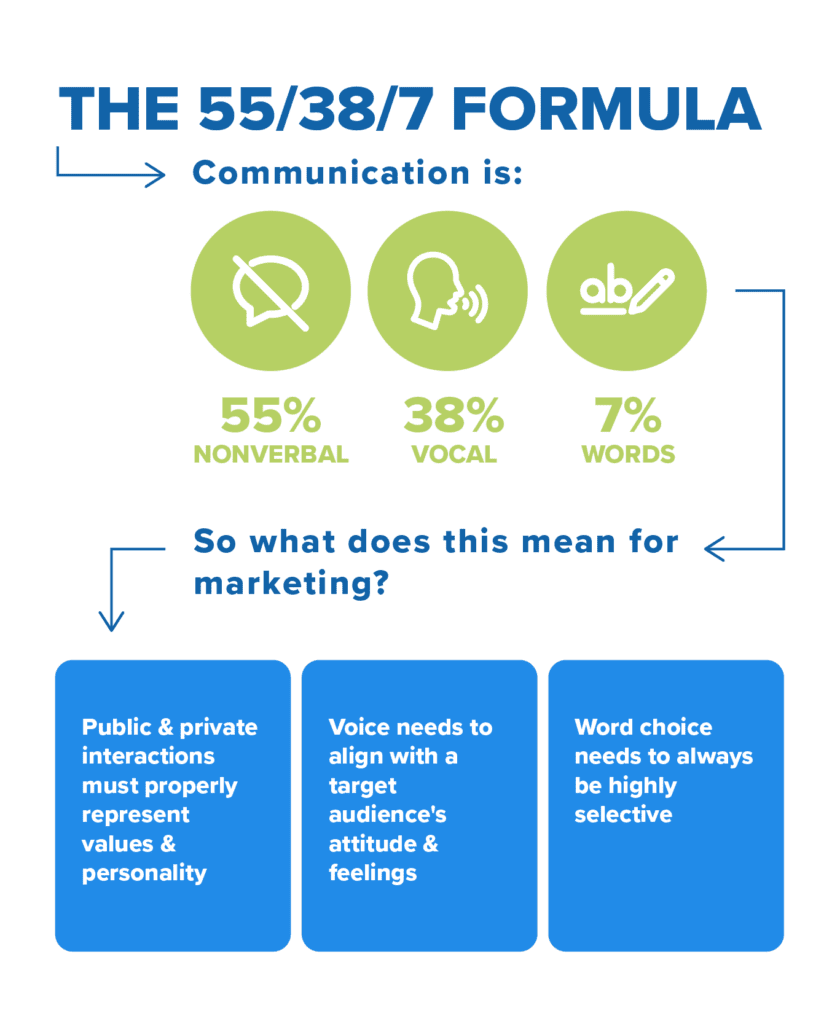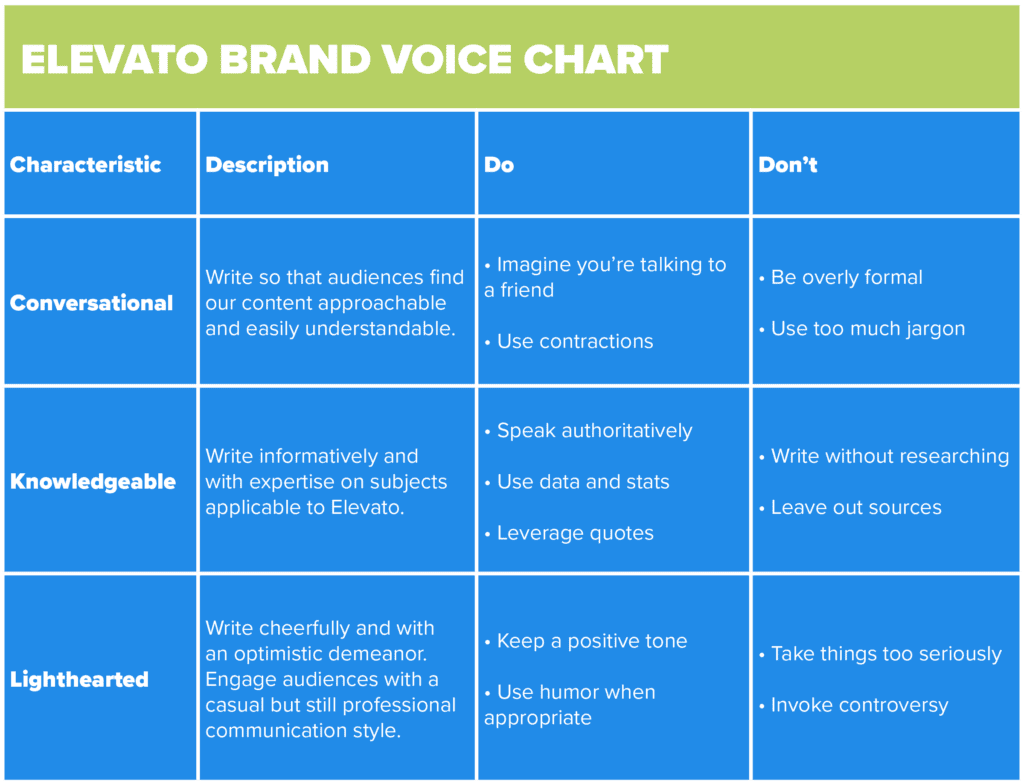Defining brand voice is an essential part of the content marketing process for new and existing businesses. Often, businesses struggle to maintain a consistent brand voice if they use multiple writers for their content and other marketing materials. This is where a brand voice chart can be beneficial.
This blog post will share what a brand voice chart is and why it is helpful for business owners and marketing teams, give a brand voice chart example, and share a guide to how to create your own brand voice chart.
What is Brand Voice?
Think of brand tone as the way your brand speaks to customers. A brand voice can have several defining brand voice characteristics that affect the tone, style, and type of communication. This encompasses the language, personality, and messaging strategy a brand uses across various channels, including social media posts, ads, blog content, website copy, customer service communications. A brand’s voice and brand’s personality is informative of the type of business it is and who its target audience is.
Why Does Brand Voice Matter?

Now that you have a clear understanding of what a brand voice is, let’s delve into why having a compelling brand voice matters for your business.
Consistency Builds Trust
Having a consistent brand voice helps build trust among your customers and prospective customers who visit your website or consume your content. In general, people like predictability and knowing what to expect. Therefore, customers will enjoy becoming familiar with your brand identity and associate trust and reliability with your business.
Create a Memorable Brand
A brand’s tone goes a long way in helping create a memorable brand experience for users. Think of your favorite brands and why they stand out to you as memorable. It’s likely a combination of aesthetic design, unique brand voice, and great products or services. A memorable brand needs a distinct brand tone to break through the noise of a saturated market.
Connect with Target Audience
Many brands connect with their target audience by using language that is relatable and relevant. For instance, a staffing company will likely be much more professional and formal in brand voice because it is speaking directly to hiring managers, HR teams, and other business professionals. On the other hand, a beauty brand will likely use a much more conversational tone with current slang terms and a confident feminine voice to connect with its target audience.
Effective Storytelling
Brand voice also plays an important role in effective storytelling. A brand essentially tells a story about why potential customers should care about what it’s selling. Storytelling is affected by brand voice in more ways than one. Think about an optimistic vs. pessimistic tone. Wouldn’t the same story sound very different in each of these scenarios?
A powerful brand voice also represents a brand’s core values. Using a consistent tone and brand messaging strategy makes storytelling highly effective.
Next, we’ll dive into the brand voice chart, how to create one, and even share a couple of brand voice chart examples to help you get started.
What is a Brand Voice Chart?
A brand voice chart is a tool used by your business to ensure that various internal and external teams are all on the same page when it comes to how your brand should communicate. This chart can be as simple or complex as you want to make it.
Once your brand voice guidelines are developed a brand voice chart can be distributed to individuals responsible for any written communication on behalf of your business. This would include marketing teams, sales and customer service teams, and advertising teams at the least.
The brand voice chart serves as a set of guidelines to help your brand communicate in the same voice and tone across all channels. Your social media captions should match the voice of your website service pages which should match your blog posts and so on and so forth. This simple tool is highly effective for ensuring your brand presents a cohesive experience for customers.
Creating a Brand Voice Chart
To create a brand voice chart for your business, you must first have fully developed your brand voice.
Establish Brand Voice
To establish a brand voice, think about your buyer personas. Who are these people and how do they speak? What age range do they fall in? Do they prefer more casual or formal communication? Ask yourself these questions to help determine what style and tone of voice you should be using to speak to your target audience. You want to connect with your audience authentically and make them feel comfortable to build trust and brand loyalty with them over time.
Additionally, consider your mission statement to find the right brand voice. A strong brand voice will take core values into consideration and use them to develop an authentic tone.
Here are a handful of characteristics and brand voice examples that may fit your brand voice:
- Playful
- Professional
- Quirky
- Serious
- Educational
- Authoritative
- Approachable
- Friendly
- Conversational
- Sophisticated
- Witty
- Creative
- Empathetic
- Lighthearted
Create a Chart That Meets Your Needs
A brand voice chart can be customized to meet your business needs. For the most basic chart, we recommend starting with these four sections.
Characteristic
In the characteristics section, you will write the characteristics that encompass your brand’s unique personality.
For the example below, the characteristics we chose are:
- Conversational
- Knowledgeable
- Lighthearted
We suggest keeping your characteristic list to a max of five to ensure using a consistent voice is truly possible.
Description
In the next column, you will write a description of each characteristic that explains how to follow the ideal brand voice style.
For the example below, here is what we put in the description boxes:
- Write so that audiences find our content approachable and easily understandable.
- Write informatively and with expertise on subjects applicable to Elevato.
- Write cheerfully and with an optimistic demeanor. Engage audiences with a casual but still professional communication style.
Do
Next, the do column is a place to add a few bullet points of examples of things that fall under the specific element of your brand voice.
For instance, in our example brand voice chart, we added these notes under the do section:
- Imagine you’re talking to a friend. Use contractions.
- Speak authoritatively. Use data and stats. Leverage quotes.
- Keep a positive tone. Use humor when appropriate.
Don’t
The don’t section is just like the do section. Add a few bullet points of what writers should avoid saying.
Here’s what we said in our example:
- Be overly formal. Use too much jargon.
- Write without researching. Leave out sources.
- Take things too seriously. Invoke controversy.
Refer Back to Brand Voice Chart Often
Once you’ve created your brand voice chart, be sure to refer back to it to keep a consistent brand voice for your business. It should be used as a helpful guide for your communications and inform your content writing.
Brand Voice Chart Example

Achieve Cohesive Communication with Elevato
Elevato is well-versed in creating brand voice charts and can assist your business with brand voice development and implementation. Our skilled content writers will effectively communicate in your brand voice across all channels to build a loyal customer base. Schedule a free consultation today to get started with Elevato.
